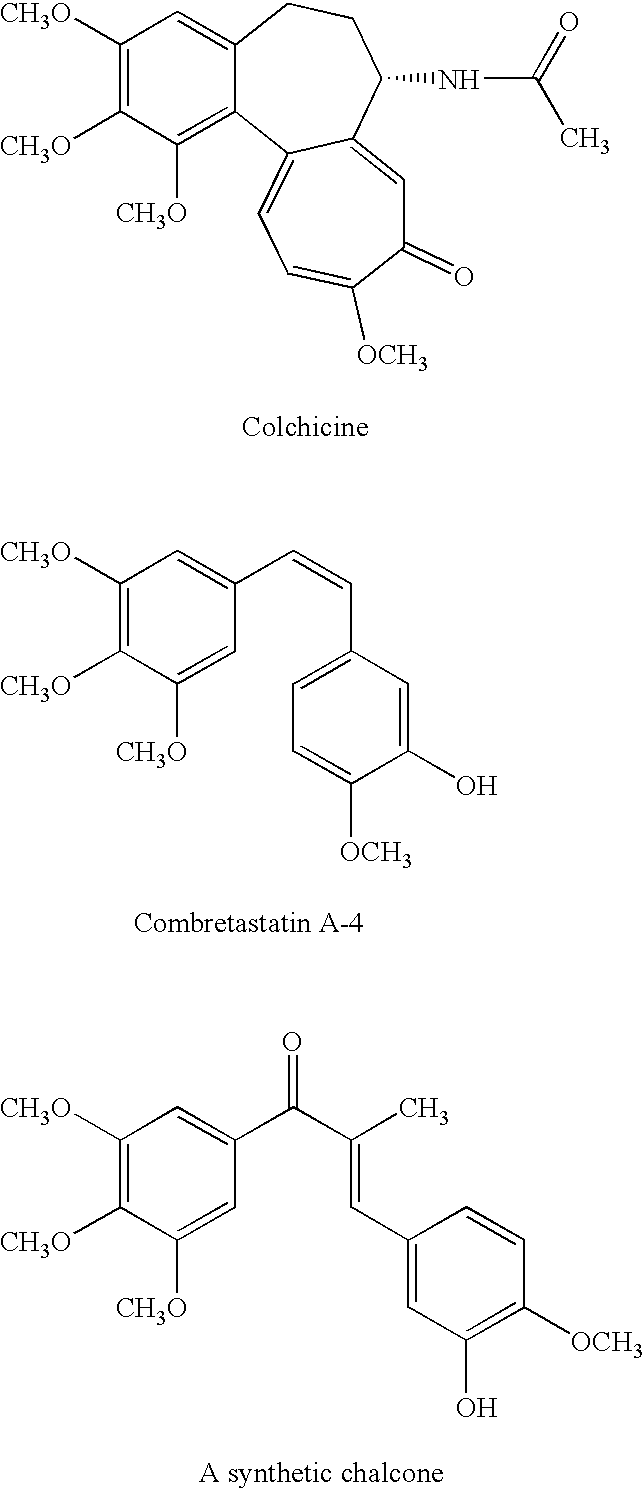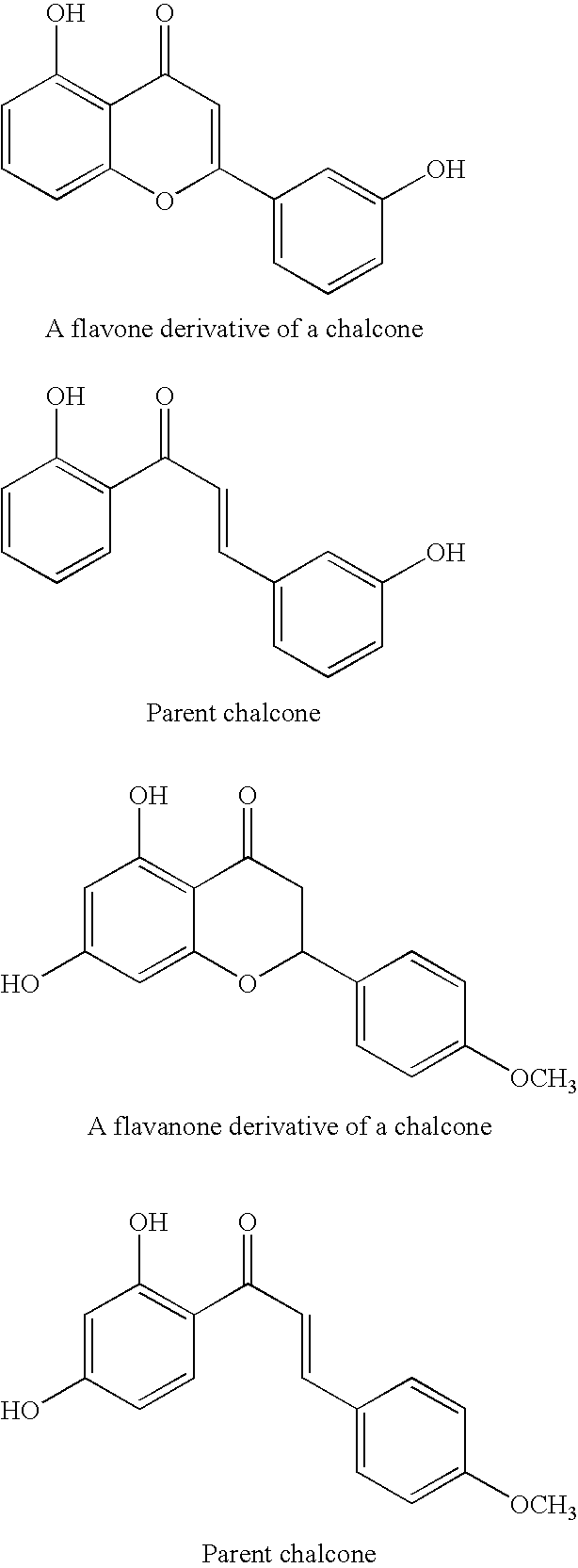Modified chalcone compounds as antimitotic agents
- Summary
- Abstract
- Description
- Claims
- Application Information
AI Technical Summary
Benefits of technology
Problems solved by technology
Method used
Image
Examples
example 1
Preparation of 3-[3-(Crotonylsulfanylmethylcarbonyloxy)-4-methoxyphenyl]-1-(3,4,5-trimethoxyphenyl)propenone (CMAC-1) and its Activity Against Cancer Cell Growth
[0140]The method of synthesis of CMAC-1 (entry 1 of Table 1) is summarized in Scheme 1.
[0141]Chalcone CMAC-1 was synthesized by esterification of the known chalcone 1 (S. Ducki, R. Forrest, J. A. Hadfield, A. Kendall, N. J. Lawrence, A. T. McGowan, and D. Rennison, Bioorg. Med. Chem. Lett., 1998, 8, 1051-1056), itself formed from 3,4,5-trimethoxyacetophenone and 3-hydroxy-4-methoxybenzaldehyde. Chalcone 1 (0.49 g, 1.42 mmol) was dissolved in 20 mL distilled dichloromethane, and the solution was chilled to 0° C. and placed under N2. To this solution were added 0.27 g (1.70 mmol, 1.2 equiv.) of but-2-enoylsulfanylacetic acid, 17 mg (0.14 mmol, 0.1 equiv.) of 4-dimethylaminopyridine (DMAP), and 0.325 g (1.70 mmol, 1.2 equiv.) of 1-(3-dimethylaminopropyl)-3-ethylcarbodiimide hydrochloride (EDAC—HCl). The reaction mixture was pro...
example 2
Preparation of 3-[5-(Crotonylsulfanylmethylcarbonyloxymethyl)-2-furyl-1]-(3,4,5-trimethoxyphenyl)propenone (CMAF-1) and its Activity Against Cancer Cell Growth
[0147]The method of synthesis of CMAF-1 (entry 11 of Table 1) is summarized in Scheme 2.
[0148]Preparation of Chalcone 2 was accomplished by Claisen-Schmidt condensation, as follows. In 5 mL methanol were dissolved 1.43 g (6.8 mmol) of 3,4,5-trimethoxyacetophenone and 1.14 g (6.8 mmol) of 5-acetoxymethyl-2-furaldehyde. After addition of 0.37 g crushed NaOH, the reaction mixture was stirred overnight to yield a dark solid material. This was taken up in methanol, collected by filtration, and washed with ice water to yield a mustard yellow powder (1.35 g, 55%). The material was recrystallized from H2O-methanol. Mp 86-88° C. 1H NMR (CDCl3) δ (ppm) 2.2 (br s, 1H), 3.93 (s, 3H), 3.95 (s, 6H), 4.70 (s, 2H), 6.42 (d, J=3.3 Hz, 1H), 6.67 (d, J=3.3 Hz, 1H), 7.28 (s, 2H), 7.38 (d, J=15.3 Hz, 1H), 7.56 (d, J=15.6 Hz, 1H).
[0149]Esterificati...
example 3
Activity Against Cancer Cell Growth of 3-[3-(2-Chloroacryloyloxy)-4-methoxyphenyl]-1-(3,4,5-trimethoxyphenyl)propenone
[0152]3-[3-(2-Chloroacryloyloxy)-4-methoxyphenyl]-1-(3,4,5-trimethoxyphenyl)propenone (entry 6 of Table 1). Mp 120-121° C. Anal. (%) Calcd. for C21H21ClO7: C, 59.93; H, 5.03. Found: C, 60.08; H, 5.04. 1H NMR (300 MHz, CDCl3) δ (ppm) 3.86 (s, C(4′a)OCH3), 3.91 (s, C(4a)OCH3), 3.93 (s, C(3a)OCH3 and C(5a)OCH3), 6.20 (d, J=2.0 Hz, CClCHH), 6.76 (d, J=3.0 Hz, CClCHH), 7.00 (d, J=8.1 Hz, C(3′)H), 7.24 (s, C(2)H, C(6)H), 7.32 (d, J=15.6 Hz, O═CCHCH), 7.43 (d, J=2.1 Hz, C(6′)H), 7.50 (dd, J=8.4, 2.1 Hz, C(2′)H), 7.73 (d, J=15.3 Hz, O═CCHCH). 13C NMR (100 MHz, CDCl3) δ (ppm) 56.2 (C(4′a)OCH3), 56.5 (C(3a)OCH3 and C(5a)OCH3), 61.0 (C(4a)OCH3), 106.0 (arom C(2), C(6)), 112.5 (arom C(3′)), 120.5 (O═CCHCH), 121.5 (arom C(6′)), 127.7 (CCl═CH2), 128.1 (arom C(1′)), 129.1 (arom C(2′)), 130.6 (CCl═CH2), 133.6 (arom C(1)), 139.8 (arom C(5′)), 142.1 (arom C(4)), 143.3 (O═CCHCH), 152.8...
PUM
| Property | Measurement | Unit |
|---|---|---|
| Fraction | aaaaa | aaaaa |
| Angle | aaaaa | aaaaa |
| Digital information | aaaaa | aaaaa |
Abstract
Description
Claims
Application Information
 Login to View More
Login to View More - R&D
- Intellectual Property
- Life Sciences
- Materials
- Tech Scout
- Unparalleled Data Quality
- Higher Quality Content
- 60% Fewer Hallucinations
Browse by: Latest US Patents, China's latest patents, Technical Efficacy Thesaurus, Application Domain, Technology Topic, Popular Technical Reports.
© 2025 PatSnap. All rights reserved.Legal|Privacy policy|Modern Slavery Act Transparency Statement|Sitemap|About US| Contact US: help@patsnap.com



